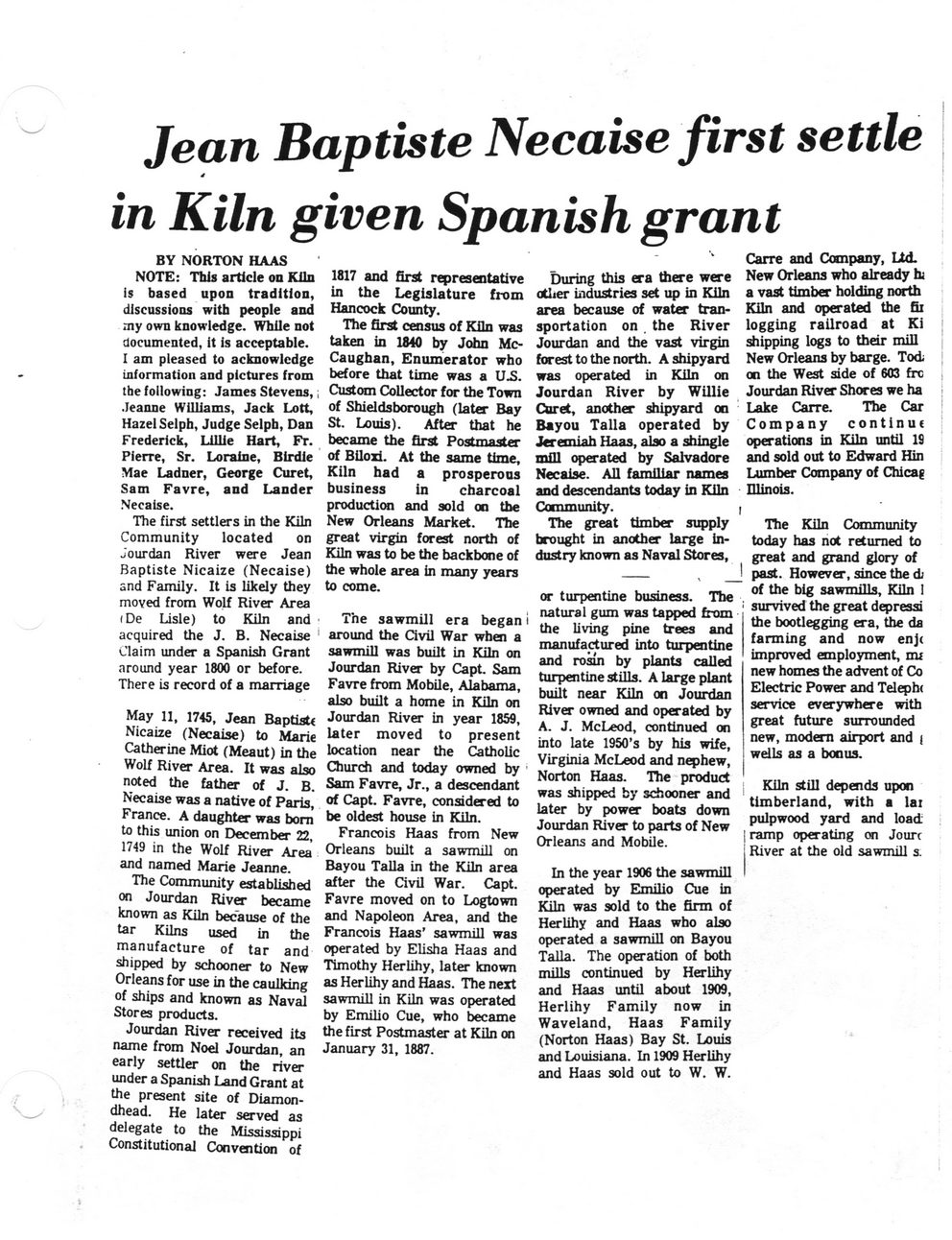This text was obtained via automated optical character recognition.
It has not been edited and may therefore contain several errors.
Jean Baptiste Necaise first settle in Kiln given Spanish grant BY NORTON HAAS NOTE: This article on Kiln is based upon tradition, discussions with people and my own knowledge. While not documented, it is acceptable. I am pleased to acknowledge information and pictures from the following: James Stevens, i Jeanne Williams, Jack Lott, Hazel Selph, Judge Selpb, Dan Frederick, Lillie Hart, Fr. Pierre, Sr. Loraine, Birdie Mae Ladner, George Curet, Sam Favre, and Lander Necaise. The first settlers in the Kiln Community located on jourdan River were Jean Baptiste Nicaize (Necaise) snd Family. It is likely they moved from Wolf River Area iDe Lisle) to Kiln and ; acquired the J. B. Necaise ' Claim under a Spanish Grant around year 1800 or before. There is record of a marriage May 11, 1745, Jean Baptist* Nicaize (Necaise) to Marie Catherine Miot (Meaut) in the Wolf River Area. It was also noted the father of J. B. Necaise was a native of Paris, France. A daughter was bom to this union on December 22, 1749 in the Wolf River Area and named Marie Jeanne. The Community established on Jourdan River became known as Kiln because of the tar Kilns used in the manufacture of tar and shipped by schooner to New Orleans for use in the caulking of ships and known as Naval Stores products. Jourdan River received its name from Noel Jourdan, an early settler on the river under a Spanish Land Grant at the present site of Diamon-dhead. He later served as delegate to the Mississippi Constitutional Convention of 1817 and first representative in the Legislature from Hancock County. The first census of Kiln was taken in 1840 by John Mc-Caughan, Enumerator who before that time was a U.S. Custom Collector for the Town of Shieldsborough (later Bay St. Louis). After that he became the first Postmaster of Biloxi. At the same time. Kiln had a prosperous business in charcoal production and sold on the New Orleans Market. The great virgin forest north of Kiln was to be the backbone of the whole area in many years to come. The sawmill era began i around the Civil War when a sawmill was built in Kiln on Jourdan River by Capt. Sam Favre from Mobile, Alabama, also built a home in Kiln on Jourdan River in year 1859, later moved to present location near the Catholic Church and today owned by Sam Favre, Jr., a descendant of Capt. Favre, considered to be oldest house in Kiln. Francois Haas from New Orleans built a sawmill on Bayou Talla in the Kiln area after the Civil War. Capt. Favre moved on to Logtown and Napoleon Area, and the Francois Haas’ sawmill was operated by Elisha Haas and Timothy Herlihy, later known as Herlihy and Haas. The next sawmill in Kiln was operated by Emilio Cue, who became the first Postmaster at Kiln on January 31, 1887. During this era there were otlier industries set up in Kiln area because of water transportation on the River Jourdan and the vast virgin forest to the north. A shipyard was operated in Kiln on Jourdan River by Willie Caret, another shipyard on Bayou Talla operated by Jeremiah Haas, also a shingle mfll operated by Salvadore Necaise. All familiar names and descendants today in Kiln Community. The great timber supply brought in another large industry known as Naval Stores, or turpentine business. The natural gum was tapped from the living pine trees and manufactured into turpentine and rosin by plants called turpentine stills. A large plant built near Kiln on Jourdan River owned and operated by A. J. McLeod, continued on into late 1950’s by his wife, Virginia McLeod and nephew, Norton Haas. The product was shipped by schooner and later by power boats down Jourdan River to parts of New Orleans and Mobile. In the year 1906 the sawmill operated by Emilio Cue in Kiln was sold to the firm of Herlihy and Haas who also operated a sawmill on Bayou Talla. The operation of both mills continued by Herlihy and Haas until about 1909, Herlihy Family now in Waveland, Haas Family (Norton Haas) Bay St. Louis and Louisiana. In 1909 Herlihy and Haas sold out to W. W. Carre and Company, Ltd. New Orleans who already hi a vast timber holding north Kiln and operated the fit logging railroad at Ki shipping logs to their mill | New Orleans by barge. Tod; j on the West side of 603 frc , Jourdan River Shores we ha Lake Carre. The Car Company continue operations in Kiln until 19 and sold out to Edward Hin Lumber Company of Chicag Illinois. I The Kiln Community today has not returned to great and grand glory of j past. However, since the d; of the big sawmills, Kiln 1 j survived the great depressi the bootlegging era, the da farming and now enjc improved employment, mi new homes the advent of Co Electric Power and Teleph< service everywhere with great future surrounded new, modem airport and | wells as a bonus. Kiln still depends upon timberland, with a lai pulpwood yard and load | ramp operating on Jourc j River at the old sawmill s.

Kiln History Jean Baptiste Necaise First Spanish Grant Settler